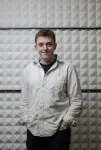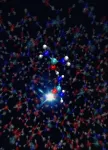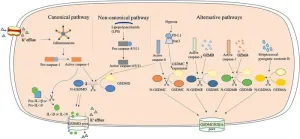(Press-News.org) HOUSTON ― A new study led by researchers at The University of Texas MD Anderson Cancer, University of California, Irvine and Baylor College of Medicine has created the world’s largest and most comprehensive map of normal breast tissue, providing an unprecedented understanding of mammary biology that may help identify therapeutic targets for diseases such as breast cancer.
The Human Breast Cell Atlas, published today in Nature, used single-cell and spatial genomic methods to profile more than 714,000 cells from 126 women. The breast atlas highlights 12 major cell types and 58 biological cell states, and identifies differences based on ethnicity, age and the menopause status of healthy women.
“We are thrilled to see the completion of this monumental seven-year project,” said senior corresponding author Nicholas Navin, Ph.D., chair of Systems Biology at MD Anderson. “We were able to leverage many technologies to define, in a very granular way, all the different cell types and cell states in each of the main areas of the breast. We expect this tool will be highly useful for anyone studying breast cancer and other diseases such as mastitis, as well as breast development and lactation failure.”
This team-science effort was led by Navin; Kai Kessenbrock, Ph.D., and Devon Lawson, Ph.D., of UC Irvine; and Bora Lim, M.D., and Alastair Thompson, M.D., of Baylor College of Medicine. The project is part of the global Human Cell Atlas consortium supported by the Chan Zuckerberg Initiative (CZI), which uses recent technologies to generate cellular reference maps for every organ system in the human body.
The human body contains roughly 200 different cell types, 12 of which are found in normal breast tissue. Previous studies on breast tissue have focused primarily on epithelial cells, given that these are known to give rise to cancer, but non-epithelial cell types have not been studied in depth using genomic approaches.
Modern tools, such as single-cell sequencing and spatial mapping, allowed the researchers to perform a highly detailed classification of 12 major cell type clusters, including three types of epithelial cells, lymphatic cells, vascular cells, T cells, B cells, myeloid cells, adipocytes, mast cells, fibroblasts and perivascular cells.
For this study, researchers collected and examined 220 breast tissue samples from 132 women undergoing breast reduction or mastectomy surgery. Of these women, 46% were Caucasian, 41% were African American, 7% were Hispanic, and 6% were of unknown ethnicity. Samples were collected across four institutions, including MD Anderson, UC Irvine, Baylor College of Medicine and St. Luke’s Hospital.
This wide-ranging dataset of normal breast cell types and their diverse states across females also takes into account individual factors including ethnicity, age, BMI, obesity, menopause status, pregnancy and number of births, providing a wealth of information that serves as a powerful resource for the research community.
Spatial mapping highlights four major cell regions, unexpected immune cell populations
Spatial mapping techniques, which create a map of the cells within the tissue environment, allowed researchers to look at the RNA and protein composition of the samples to understand how and where the different cell types reside.
These techniques resolved the composition of known cell types and new cell states in the four main regions currently known in the breast, including lobular milk-producing areas, ductal areas that transport milk, connective tissue composed of fibroblasts, and adipose areas made up primarily of fatty tissue.
The researchers were surprised to learn that 16.7% of all cells found in normal breast tissue were composed of immune cells, including the three major types: myeloid, natural killer (NK) T cells and B cells. Scientists previously thought that few immune cells would be found in normal tissue.
Additionally, these immune cells were located primarily around ducts and lobules in three of the four major tissue regions. Understanding the nuances of these different immune cells could help in developing more effective immunotherapies for some subtypes of breast cancer, Navin explained, and in defining their role in breast cancer progression.
The researchers also found an unexpectedly high amount (7.4%) of perivascular cells, including pericytes, which regulate blood flow from capillaries into tissues, and vascular smooth muscle cells, which regulate contractions of the arteries.
Age, menopause and ethnicity play roles in different cell types and cell states
The study revealed significant differences in breast tissue composition and cell states that were dependent upon ethnicity, age and menopause status.
For example, African American women are disproportionally affected by aggressive breast cancer subtypes, such as triple-negative breast cancer and inflammatory breast cancer, but little is known about the underlying causes of this disparity. The differences seen in baseline cell states in breast tissues from African American women and Caucasian women could, with further research, highlight potential markers for cancer risk prediction.
Additionally, there were significant differences in the breast tissues from women over the age of 50 compared to younger women, as well as differences in cell states dependent on menopause status. Obesity, body-mass index, pregnancy status and breast density also showed some smaller differences in changes of cell types and cell states.
The authors point out that more studies are needed to further understand the functional role of many of these cell states and to focus on other factors that may significantly advance the knowledge of human breast biology and disease.
The Human Breast Cell Atlas project is ongoing and is actively recruiting participants to build upon and improve the datasets, but the data is freely available now for researchers to access.
This work was supported by the Chan Zuckerberg Initiative, the National Cancer Institute (RO1CA240526, RO1CA236864, 1R01CA234496, F30CA243419), the Cancer Prevention and Research Institute of Texas (CPRIT) Single Cell Genomics Center (RP180684), the American Cancer Society, the Rosalie B. Hite Fund for Cancer Research Fellowship, and the California Institute for Regenerative Medicine (CIRM) Training Grant. A full list of collaborating authors and their disclosures can be found with the full paper here.
- 30 -
END
Scientists using one of the world’s most powerful quantum microscopes have made a discovery that could have significant consequences for the future of computing.
Researchers at the Macroscopic Quantum Matter Group laboratory in University College Cork (UCC) have discovered a spatially modulating superconducting state in a new and unusual superconductor Uranium Ditelluride (UTe2). This new superconductor may provide a solution to one of quantum computing’s greatest challenges.
Their finding has been published in the prestigious journal Nature.
Lead author Joe Carroll, a PhD researcher working with UCC Prof. of Quantum Physics Séamus Davis, explains the subject of the paper.
“Superconductors ...
A team of researchers led by Feng Zhang at the Broad Institute of MIT and Harvard and the McGovern Institute for Brain Research at MIT has uncovered the first programmable RNA-guided system in eukaryotes — organisms that include fungi, plants, and animals.
In a study in Nature, the team describes how the system is based on a protein called Fanzor. They showed that Fanzor proteins use RNA as a guide to target DNA precisely, and that Fanzors can be reprogrammed to edit the genome of human cells. The compact Fanzor systems have the potential to be more easily delivered to cells and tissues as therapeutics than CRISPR/Cas systems, ...
New images from the James Webb Space Telescope have revealed, for the first time, starlight from two massive galaxies hosting actively growing black holes – quasars – seen less than a billion years after the Big Bang. A new study in Nature this week finds the black holes have masses close to a billion times that of the Sun, and the host galaxy masses are almost one hundred times larger, a ratio similar to what is found in the more recent universe. A powerful combination of the Subaru Telescope and the JWST has paved a new path to study the distant universe.
The existence of such massive black holes in the distant universe has created more questions ...
Maunakea, Hawaiʻi - When our Sun reaches the end of its life, it will expand to 100 times its current size, enveloping the Earth. Many planets in other solar systems face a similar doom as their host stars grow old. But not all hope is lost, as astronomers from the University of Hawaiʻi Institute for Astronomy (UH IfA) have made the remarkable discovery of a planet’s survival after what should have been certain demise at the hands of its sun.
The Jupiter-like planet 8 UMi b, officially named Halla, ...
Contact: Bess Connolly, 203-432-1324 or elizabeth.connolly@yale.edu
Embargoed For Release: 11 A.M. ET June 28, 2023
Genetic variant linked with faster progression of multiple sclerosis
New Haven, Conn. — A study of more than 22,000 people with multiple sclerosis (MS) has for the first time identified a genetic variant associated with faster progression of the disease, an accumulation of disability that can rob patients of their mobility and independence over time.
Multiple sclerosis begins as an autoimmune disease where the immune system attacks the brain and the spinal cord, resulting in symptom flares, called relapses, as well as longer-term degeneration known ...
How did life begin on Earth? Experts have long been fascinated by this question and over the years have come up with a variety of theories. One hypothesis is that the origin of life can be traced back to warm little ponds which are thought to have existed on Earth four billion years ago. The water in these ponds probably contained urea molecules; these were exposed to ultraviolet radiation from the sun, which at that time would have penetrated to the surface of the earth largely unimpeded. This high-energy radiation was able to convert ...
Lung cancer, one of the most aggressive forms of cancer, continues to be a leading cause of death worldwide. Although several new therapies have been developed for this disease, it has a poor prognosis in its advanced stages. A primary reason underlying this poor response to treatment is the formation of a tumor microenvironment (TME)— the environment that surrounds a tumor and plays a crucial role in its growth. To develop approaches that can overcome treatment resistance during the advanced stages of this cancer, we need to understand ...
ROCKVILLE, MD—JUNE 15, 2023 – In response to the allegations of illicit buying and selling of stolen body parts from Harvard Medical School's body donation program, the American Association for Anatomy (AAA) stands united in strong condemnation of the commercialization of human body donors and any action that violates donor ethics and trust. Our heartfelt support goes out to the affected families.
Any act that violates the principles of respect and dignity owed to every individual, in life or death, undermines the sanctity of ...
FOR IMMEDIATE RELEASE
Johns Hopkins Medicine scientists say they have developed a nanoparticle — an extremely tiny biodegradable container — that has the potential to improve the delivery of messenger ribonucleic acid (mRNA)-based vaccines for infectious diseases such as COVID-19, and vaccines for treating non-infectious diseases including cancer.
Results of tests in mice, reported June 20 in the Proceedings of the National Academy of Sciences, show that the degradable, polymer-based nanoparticle carrying an mRNA-based vaccine, when injected into the ...
A projected rise in droughts could muddy the waters for painted turtles and some fellow freshwater-dwelling reptiles, says 11 years of data collected by 50-plus undergraduates from the University of Nebraska–Lincoln.
Two recent studies based on the data suggest that drought can lower the survival odds, slow the growth and even skew the ratio of female-to-male painted turtles inhabiting the ponds of the Cornhusker State. Those outcomes emerged despite the water level of a sampled pond in southwestern Nebraska remaining relatively steady throughout the observed periods ...








